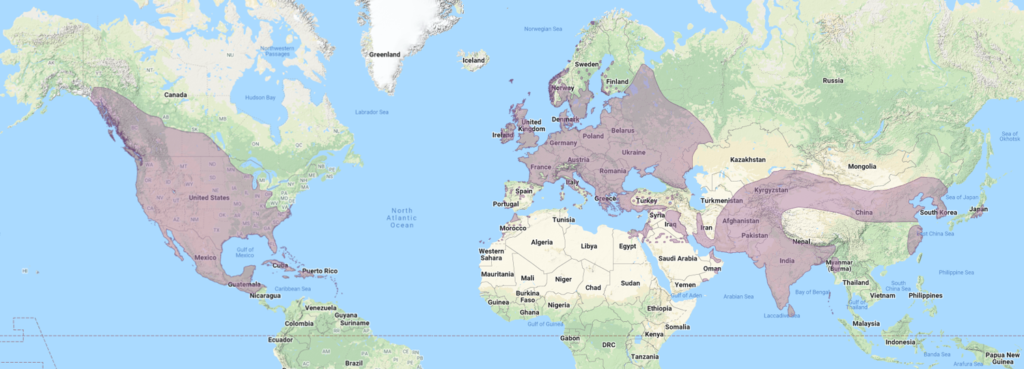Birdfinding.info ⇒ Among the most widespread, numerous, humanity-adapted, familiar bird species on the planet. Common to abundant in towns and agricultural lands nearly throughout Europe, the Middle East, and the Indian subcontinent. Increasingly ubiquitous in North America as well, following a spectacularly successful colonization that began in the 1980s.
Eurasian Collared-Dove
Streptopelia decaocto
Native to Eurasia; introduced to North America.
Comprises two distinct forms: the widespread “Eurasian Collared-Dove” (decaocto), discussed in detail below, and the localized “Burmese Collared-Dove” (xanthocycla), discussed in more detail here.
Widespread across much of Eurasia and North America. Formerly an Asian species, it has undergone two massive and well documented range expansions in recent times, first across Europe in the early to mid-1900s, then across North America starting in the 1970s and continuing to the present day.
Thrives in all types of settled areas, including densely populated cities, suburbs, villages, and agricultural zones. It seems to gravitate to these altered landscapes, following corridors of development with limited occupation of natural habitats. Within its anthropogenic niche, it resides an impressive range of climates, from tropical to arctic and humid to arid. However, it is also inexplicably absent from large areas of apparently suitable habitat within its expansive and expanding global range.

North American Breeding Bird Survey Abundance Map: Eurasian Collared-Dove. U.S. Geological Survey 2015
In Eurasia, resident nearly throughout Europe from the Faroes, southern Norway, and north-coastal Finland south to the Mediterranean and east to the Caspian Sea. More localized across temperate regions of Asia from Turkey south to the Nile Delta and east across Iraq, Iran, the central Asian republics, Mongolia, and northern China to Hebei (and locally or sporadically east to Liaoning and south to Hong Kong); and throughout tropical southern Asia south to Sri Lanka and east to India’s easternmost provinces.
Vagrants are recorded fairly often beyond its established Eurasian range: to Iceland, north-coastal Norway, southeastern Siberia, and Japan.
Expanding locally southward in the Middle East, apparently throughout the Arabian Peninsula and Egypt, and in northwestern Africa from Morocco east to northwestern Libya, south along the coast to Senegal and in the interior to southern Algeria.
In Macaronesia, it is well-established throughout the Canary Islands, and during the 2000s has expanded to the Azores, Madeira, and Cabo Verde—likely to become established on all major islands of each archipelago soon if not already.
In North America, the original introductions to the Americas reportedly occurred on New Providence (Bahamas) in 1974 and Guadeloupe in 1976. It has expanded rapidly throughout most of the continent and is resident from southeastern Alaska south to the tip of Baja California, east across British Columbia, the Canadian prairies, and most of the continental U.S. (but mostly absent northeast of Ohio and North Carolina), south to Panama, and throughout the West Indies south to Grenada.
Further expansion in the Americas seems likely to continue for many years—especially in the northeastern U.S. and southeastern Canada, where it remains curiously localized.
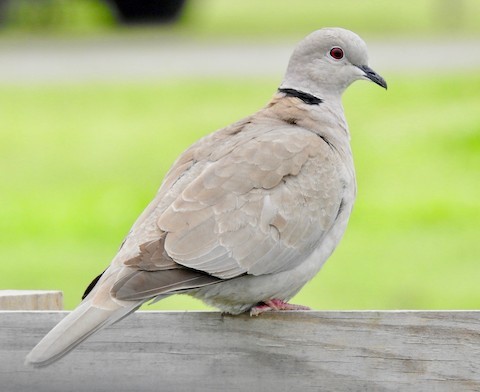
Between the 1990s and the 2010s, the Eurasian Collared-Dove rose from obscurity to beome a familiar suburban bird across most of North America. (Farr Park, Baton Rouge, Louisiana; March 2, 2019.) © Van Remsen
Vagrants are often recorded beyond its established North America range: as far as central and southwestern Alaska, the Yukon, the Northwest Territories, southern Quebec, and Newfoundland.
The “Burmese” form, xanthocycla, appears to be endemic to the Irrawaddy Valley of central and southern Myanmar. It has also been reported in Yunnan and farther east in China, but it is not clear which of these reports, if any, are well-substantiated, and which are based on inaccurate assumptions.
Identification
A sandy-brown turtle-dove with a black half-collar and black-and-white tail pattern that is visible mostly from below when the tail is spread.

Eurasian Collared-Dove, showing typical plumage and dark-red iris. (Fontana, San Bernardino County, California; April 12, 2020.) © Sal Giambruno
At rest, the wings and back are typically pale-brown, while the head, neck and body are tan—but often with a subtle pinkish blush. Overall coloration varies, however, as many individuals show darker-brown or grayish upperparts.
The black half-collar is accentuated by a distinct whitish border above and a less distinct whitish border below.
Several other Streptopelia species are distinguishable by voice, eye and orbital skin coloration, and aspects of the wing and tail patterns that are most visible in flight. In some areas it overlaps with its extremely similar relative, the African Collared-Dove (roseogrisea)—voice is the best, and often the only reliable means of identification (see detailed comparison below).
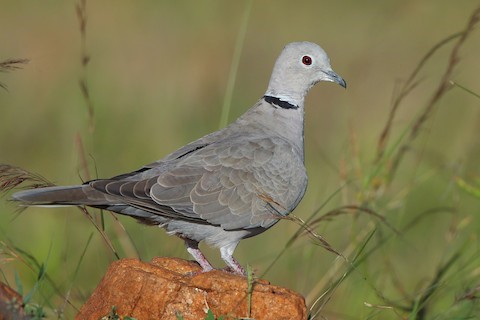
Eurasian Collared-Dove with plumage appearing grayish overall. (Jayamangali Blackbuck Conservation Reserve, Karnataka, India; September 10, 2021.) © Albin Jacob
The eyes are dark-red, but often appear dark-brown or black when not fully illuminated. The orbital skin is whitish or very pale powder-yellow.
The legs are typically reddish, but vary from pink to dull-purplish or dark-gray.
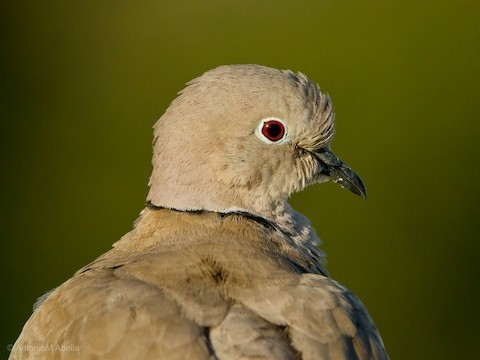
Eurasian Collared-Dove, showing dark-red iris and whitish orbital skin. (Cumbres de San Antonio, Bétera, Comunidad Valenciana, Spain; April 5, 2020.) © Antonio M. Abella
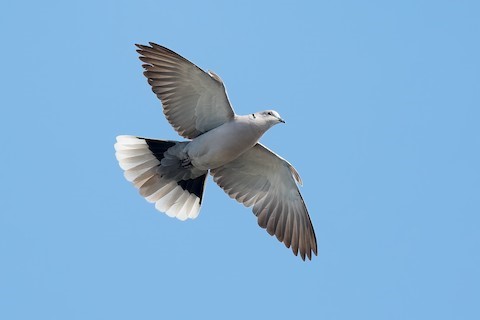
Eurasian Collared-Dove, showing typical undertail pattern—gray undertail coverts that contrast with black-and-white tail feathers. (Rosemont, Sacramento, California; May 16, 2021.) © Dan Brown
The underside of the tail feathers is mostly white, except that the bases of the outer tail feathers are jet-black—the black bases are most visible in flight, but often remain visible when the tail is folded. The undertail coverts are typically gray—not as white as the tail feathers. Eurasian’s contrasting white, black, and gray undertail pattern differs from the African Collared-Dove’s undertail, which tends to appear all-white.
Seen from above, when the tail is spread, the outer corners are extensively whitish, the base is dark gray or blackish on the sides, and the rump and central tail feathers form a brownish wedge in the middle.
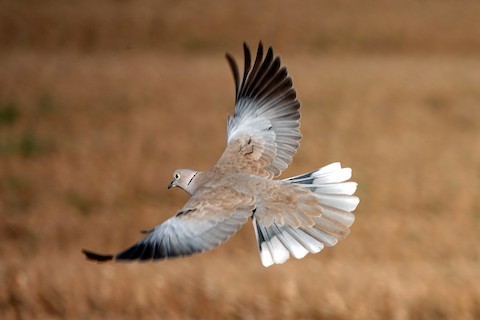
Eurasian Collared-Dove, showing pale gray band across the upperwing, and uppertail with broad white outer corners, blackish corners at the base, and a brown wedge in the middle. (Kudowa-Zdrój, Dolnoslaskie, Poland; September 15, 2018.) © Romuald Mikusek

Eurasian Collared-Dove, showing pale gray band across the upperwing. (Prewitt Reservoir, Colorado; June 6, 2017.) © Steven Mlodinow
In flight, the uppersides of the wings show a broad pale-gray diagonal band between the blackish primaries and pale-brown inner coverts.
“Burmese Collared Dove”. The Burmese endemic form, xanthocycla, differs from the widespread decaocto most obviously in having a broad brght-yellow eyering. “Burmese” also differs in having darker-brown plumage overall, and a more muted undertail pattern.
However, some individuals of the widespread “Eurasian” form, decaocto, have atypically wide yellowish eyerings and could be mistaken for “Burmese”, so this single characteristic is not always definitive.

“Burmese Collared-Dove”, S. d. xanthocycla, showing prominent wide vivid-yellow eyering. (Bagan, Mandalay, Myanmar; December 12, 2019.) © Balaji P B

“Eurasian Collared-Dove”, S. d. decaocto, showing an atypically wide yellowish eyering—thus resembling the “Burmese Collared-Dove”. (Jorbeer Vulture Conservation Centre, Bikaner, Rajasthan, India; November 30, 2019.) © Savithri Singh
Notes
Polytypic species consisting of two recognized subspecies that are potentially distinct forms: the “Eurasian Collared-Dove” (decaocto) and the “Burmese Collared-Dove” (xanthocycla). Based on apparent differences in bare parts, plumage coloration, and voice, it seems likely that the “Burmese” form will eventually be recognized as a separate species.
See below for a comparison of the Eurasian Collared-Dove with the African Collared-Dove.
Cf. African Collared-Dove. The Eurasian and African Collared-Doves do not occur together naturally, but their close associations with humanity increasingly bring them into contact: in West Africa, the Arabian Peninsula, the Canary Islands, and Puerto Rico.
They can be essentially identical, with overlapping measurements and general coloration, and limited differentiation in their plumage patterns. Eurasian is somewhat larger on average, both longer and bulkier, but the size differences are not pronounced or consistent enough to be reliable in field identification.
Voice: Their most reliable distinguishing feature is their typical vocalizations. Eurasian gives a relatively clear, rhythmic, three-syllable call, whereas African gives a rolling, purring call. These typical calls are usually diagnostic. But some Eurasian calls are rougher than average, some African calls are clear, and both can vary in their cadences, so voice is not always a certain indicator.

Eurasian Collared-Dove, showing extensive black base on underside of folded tail. (Sangamon, Illinois; January 4, 2015.) © Dennis Oehmke
Undertail Pattern: Apart from vocalizations, the most consistent diagnostic differences are in the undertail. Both species have extensive white tips and a black base, but they differ in the amount of black and the coloration of the undertail coverts. The black base on Eurasian’s undertail is usually visible when the tail is folded, whereas African typically shows a smaller black area that becomes visible only when the tail is spread. Eurasian’s undertail coverts are usually grayish, darker the white of the tail-feathers, whereas African’s undertail coverts are whitish, about the same shade as the tail-feathers, or sometimes paler. However, these differences are tendencies, not 100% consistent.

African Collared-Dove, showing mostly white undertail with narrow blackish corners at the base. (Levittown, Toa Baja, Puerto Rico; February 28, 2017.) © Gil Ewing
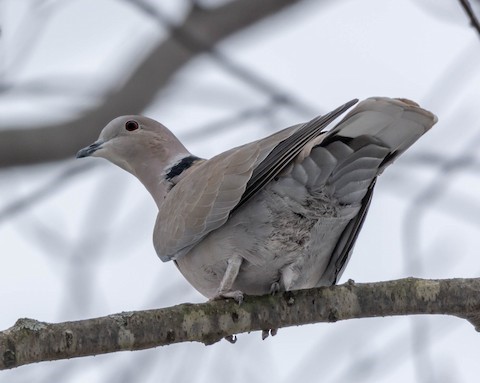
Eurasian Collared-Dove, showing gray undertail coverts contrasting with whiter tail feathers. (Manhattan, Illinois; January 18, 2019.) © Jim Lukancic

Eurasian Collared-Dove, showing gray undertail coverts contrasting with black-and-white tail-feathers. (Sainte-Marthe, Vaudreuil-Soulanges, Quebec; January 12, 2021.) © Michel Laquerre

African Collared-Dove, showing uniformly whitish undertail—with no contrast between the coverts and tail-feathers. (Cabo Rojo, Puerto Rico; April 14, 2009.) © Bill Hubick
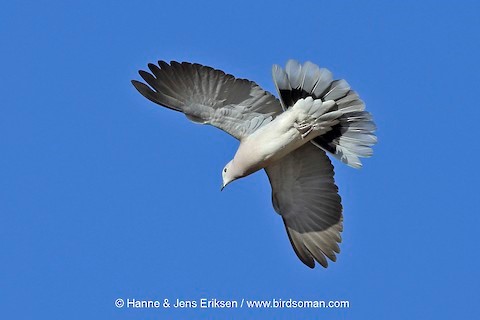
African Collared-Dove, showing essentially concolor undertail coverts and undertail—whether more whitish or grayish (as they appear in this photo), the lack of contrast is more typical of African than Eurasian. (Al Mazyunah, Dhofar, Oman; February 17, 2016.) © Jens Eriksen
Upperparts Coloration: Eurasian’s upperparts tend to appear somewhat browner and darker, often contrasting with its pale head and neck, whereas African’s upperparts tend to appear more uniform and sand-colored. However, these differences in coloration are variable, with broad overlap between the two species, and mostly unreliable for identification.
Uppertail Pattern: Some identification references depict differences in the uppertail patterns—showing African with a pronounced brown wedge between the black base and white outer tips, and showing Eurasian with a broader band of white—but this is not a reliable distinction.
Wings: Some identification references depict differences in wing patterns—showing Eurasian with more contrasting coloration on both the upperside and the underside—but these are not reliable distinctions. On the upperside of the spread wing, both species have dark primaries and sandy coverts, and both can show a bright pale gray patch in mid-wing—Eurasian apparently always has this patch, but African can show it as well. On the underside of the wing, Eurasian tends to appear mostly whitish, whereas African often shows a more neutral grayish tone—but these appearances depend on lighting and both species seem to vary.
More Images of the Eurasian Collared-Dove

Eurasian Collared-Dove with warm-brown plumage. (Delongo, Santarém, Portugal; February 17, 2022.) © Milas Santos
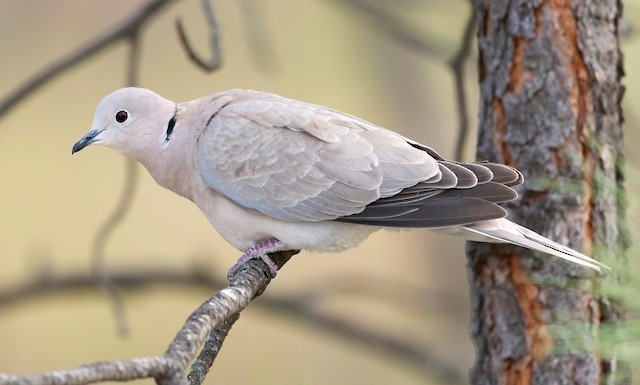
Eurasian Collared-Dove, an atypically pale individual. (Lillooet, British Columbia; May 5, 2018.) © Ian Routley

Eurasian Collared-Dove, likely a juvenile, judging from its mostly uniform brownish plumage and partly developed black semi-collar. (Helen’s Pond, Dungeness, Washington; September 6, 2017.) © John F. Gatchet
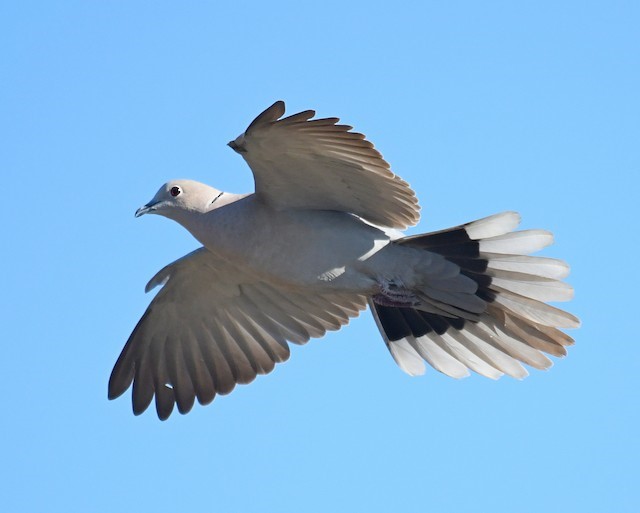
Eurasian Collared-Dove, showing typical undertail pattern with gray undertail coverts contrasting with black and white tail feathers. (Bolsa Chica Ecological Reserve, Orange County, California; February 4, 2018.) © Dan Murphy
References
Alderfer, J., and J.L. Dunn. 2014. National Geographic Complete Birds of North America (Second Edition). National Geographic Society, Washington, D.C.
BirdLife International. 2019. Streptopelia decaocto. The IUCN Red List of Threatened Species 2019: e.T22727811A154457750. https://dx.doi.org/10.2305/IUCN.UK.2019-3.RLTS.T22727811A154457750.en. (Accessed March 2, 2022.)
Brazil, M. 2009. Birds of East Asia. Princeton University Press, Princeton, N.J.
eBird. 2022. eBird: An online database of bird distribution and abundance. Cornell Lab of Ornithology, Ithaca, N.Y. http://www.ebird.org. (Accessed March 2, 2022.)
Garcia-del-Rey, E. 2011. Field Guide to the Birds of Macaronesia: Azores, Madeira, Canary Islands, Cape Verde. Lynx Editions, Barcelona.
Garcia-del-Rey, E. 2018. Birds of the Canary Islands. Christopher Helm, London.
Gibbs, D., E. Barnes, and J. Cox. 2001. Pigeons and Doves: A Guide to the Pigeons and Doves of the World. Yale University Press, New Haven, Connecticut.
Kirwan, G.M., A. Levesque, M. Oberle, and C.J. Sharpe. 2019. Birds of the West Indies. Lynx Edicions, Barcelona.
Porter, R.F., S. Christensen, and P. Schiermacker-Hansen. 1996. Field Guide to the Birds of the Middle East. T & A D Poyser, London.
Redman, R., T. Stevenson, T., and J. Fanshawe. 2009. Birds of the Horn of Africa: Ethiopia, Eritrea, Djibouti, Somalia, and Socotra. Princeton University Press.
Sinclair, I., and P. Ryan. 2003. Birds of Africa South of the Sahara. Princeton University Press.
Svensson, L., K. Mullarney, and D. Zetterström. 2009. Birds of Europe (Second Edition). Princeton University Press.
van Perlo, B. 2002. Birds of Western and Central Africa. Princeton University Press, Princeton, N.J.
Xeno-Canto. 2022. Eurasian Collared Dove – Streptopelia decaocto. https://xeno-canto.org/species/Streptopelia-decaocto. (Accessed March 2, 2022.)

